My first marketing job was as a contract writer for an agency on the opposite side of the world. This also happened to be my first “real” job and, consequently, my first experience of remote work.
Since then, I’ve worked with several other companies across multiple time zones and, as a result, experienced everything remote work has to offer — from the challenges of setting up a home office to the joys of location independence.
But more importantly, I’ve also gotten to consciously observe the growth and impact of remote work over time.
In this post, I’ll be sharing 60 statistics to help you understand the evolution, opportunities, and challenges this unique mode of work offers.
Each section is designed to provide more than just statistics and instead offer you a cohesive, research-backed narrative on each sub-topic.
Table of Contents
The Introduction and Evolution of Remote Work
- According to Hubspot, the most popular work model today is a hybrid model, which is preferred by 41% of employees. This is followed by the fully remote work model (32%), and, finally, on-site work (27%). However, interestingly, before 2020, most employees had fully on-site jobs with no immediate plans to switch to alternative models. So, what changed?
- The 2020 lockdown mandated a complete shift to remote work across most industries, introducing many to remote work for the first time. Consequently, an Owl Labs survey found that this experience led to 70% of employees wanting to maintain a hybrid or remote working arrangement even post-pandemic.
- By 2021, an Accenture study found that 83% of global workers viewed this hybrid model of work (a mix of remote and on-site work) as ideal.
- As time went on, worker preferences kept evolving. A 2022 study found that the preferred working styles shifted a bit from the previous year. Remote work was favored by 34% in 2021 but dropped to 29% in 2022. Hybrid work went from 31% to 36%, and in-office work went from 29% to 22%.
- Breaking it down by gender, women seemed to favor remote work more (46%) over men (39%). On the other hand, in-office work seemed more appealing to men, with 24% preferring it compared to 19% of women.
- This study also found that around 29% of workers changed jobs, with remote workers being twice as likely (37%) to switch compared to those working in an office (21%). The top reasons for changing jobs were better pay (84%), better career opportunities (82%), and better work/life balance (78%).
- But what was even more interesting was that according to participants in the study, if the option to work remotely in their current jobs was taken away, 66% said they would start looking for a job that offered more flexibility, while 39% said they would simply quit.
- Similarly, another 2022 survey found that 63% of workers would choose a better work-life balance over better pay.
- And these sentiments weren’t short-term. A 2022 study by Buffer found that 98% of respondents wanted to work remotely in some capacity for the rest of their careers.
- Similarly, another study found that 88% of workers considered hybrid work as a leading benefit they’d expect in a new job.
- Remote work options were so positively received that only 1% of participants in a study by Buffer reported having a negative experience with remote work.
- Additionally, the study also found that 98% of remote workers would recommend remote work to others.
- Studies continue to consistently show that many workers prefer a remote or hybrid arrangement over on-site work. For instance, Atlassian’s State of Work study showed a notable shift in the preferences of remote, office-only, and hybrid workers between 2021 and 2022: 22% in 2022 versus 34% in 2021, 35% in 2022 versus 39% in 2021, and 43% in 2022 versus 27% in 2021, respectively.
- Overall, the hybrid model of remote work appears to be the happy medium between workers and employers, with 45.5% of remote workers having hybrid arrangements compared to 20.5% who work fully from home, according to a January 2023 survey.
How Companies Have Responded to Remote Work
- Before the 2020 shutdown, just 8% of companies had flexible workplace policies.
- By 2021, nearly two-thirds (62%) had implemented some level of flexible work. Mid-size companies (501-5,000 employees) specifically, were particularly proactive, with 70% implementing flexible work policies.
- However, employer sentiments toward remote work continued to evolve. That same year, a report by OwlLabs found that 73% of those who worked from home during the pandemic eventually returned to the office at least one day a week.
- In reality, while 74% of companies promised some level of flexibility in work schedules at the time, 82% were also planning a return to pre-pandemic work schedules after the lockdown.
- By 2022, the State of Remote Work report found that only 31% of employers were offering fully remote working options, with 41% of small companies (10-50 employees) requiring employees to return to the office.
- So, where exactly does that leave us today? It honestly depends on who you ask. On one hand, 58% of participants in a McKinsey survey reported having the opportunity to work from home at least one day a week.
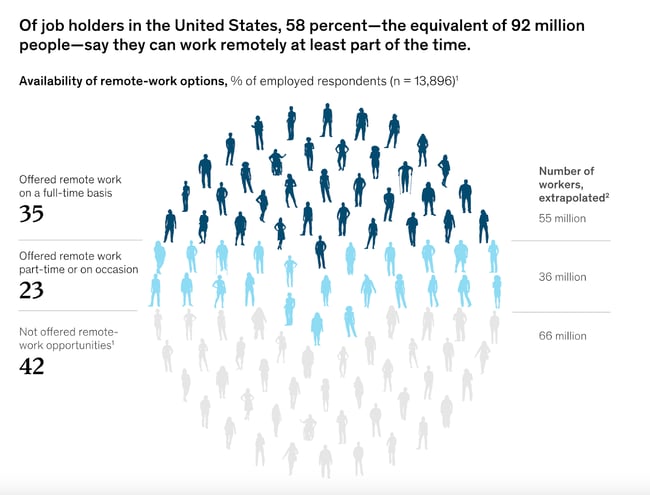
- On the other hand, several studies have found that remote work is the exception and not the norm. According to a study by Accenture, as of 2022, 36% of workers worldwide had returned to a fully on-site work model across all industries.
- Another survey by Atlassian also revealed that 82% of all knowledge workers had some form of “in-office mandate,” while 25% of workers who supposedly had the choice to work remotely still felt pressure to go into the office.
- Finally, a 2022 U.S. Bureau of Labor Statistics survey found that only 27.5% of private sector businesses (2.5 million) had employees teleworking all or some of the time.
- So, how do we interpret this seemingly conflicting data? Well, all perspectives may have merit. By examining each industry individually rather than collectively, the data aligns better.
- The same study by the U.S. Bureau of Labor Statistics found that professional and business services, educational services, and wholesale trade boasted the highest percentage of teleworkers at 67.4%, 49%, 46%, and 39%, respectively. This suggests that remote work opportunities are simply more prevalent in certain industries, and study results will often vary depending on the industry surveyed.
Why Workers Prefer Remote Work
- For many workers, the appeal of remote work lies in its flexibility. According to Hubspot’s Hybrid Work Report, 90% of employees are dealing with some level of burnout and believe that flexibility, especially in taking time off, could significantly reduce their stress levels.
- But flexibility isn’t just about when you work. According to findings from a Buffer study, the biggest remote work benefits for workers include being able to manage their time (22%), choose where they live (19%), and decide where they work (13%).
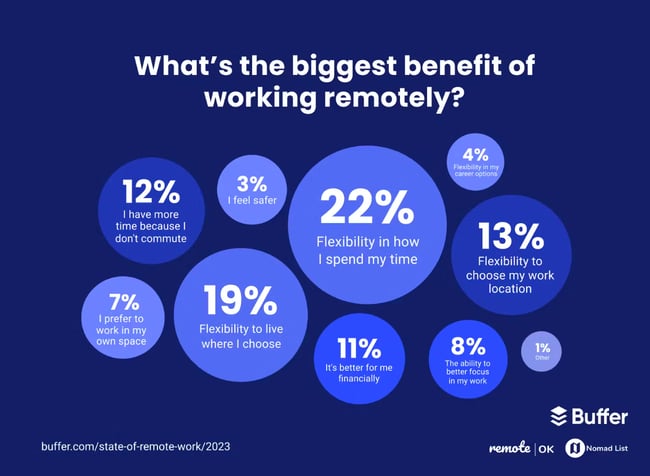
- Atlassian’s research provides further insight, showing that the primary reason US knowledge workers prefer remote work is that they are simply happier working from home (47%).
- But beyond happiness and flexibility, remote workers also report higher productivity levels. According to a study by Owl Labs, a large majority (62%) of workers feel more productive when working remotely, compared to just 11% who feel less productive.
- A Buffer study also found that 70% of workers find it easier to focus, 65% manage stress better, and 50% avoid distractions better when working remotely.
- Finally, while the office is seen as the most productive environment for certain activities, such as meeting new people (59%), managing others (51%), and team meetings (51%), workers are split on where they prefer to innovate and brainstorm. Some thrive in the office (39%), while others seem to find their flow better at home (37%).
The Business Impact of Remote Work
- Remote work, whether fully remote or hybrid, often incurs expenses that are not typically associated with traditional work models. According to findings from Buffer’s State of Remote Work Report, 64% of employees indicated that their companies paid for hardware such as monitors, while 40% reported that their companies covered costs associated with home office equipment.
- Interestingly, home internet, which is arguably the most crucial remote work tool, is only covered by 28% of companies.
- Another additional remote working cost companies often have to cover is coworking memberships. 22% of respondents in the Buffer survey indicated that their companies cover their memberships, while 38% expressed a desire for their companies to do so.
- Now, other than employee expenses, businesses also need to consider how remote work might affect profitability. For example, HubSpot’s 2024 State of Sales Report revealed that 46% of salespeople perceive selling remotely as less effective than in-person sales.
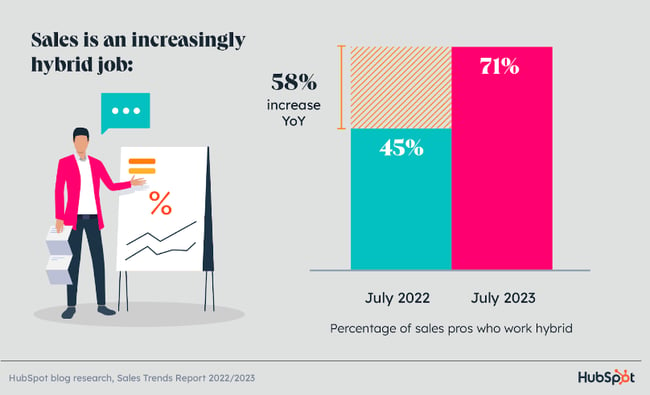
- So, what does this mean? Is remote work simply an added expense with no real benefits to the bottom line? On the contrary, remote work also offers major financial benefits. According to a study by IWG, more than four-fifths of Chief Financial Officers (CFOs) (82%) believe that remote work, specifically in a hybrid format, is a more cost-effective business model compared to traditional office setups.
- This line of thinking is supported by findings from Global Workplace Analytics, which suggests that hybrid working arrangements can save organizations more than $11,000 per employee annually on average.
- But how exactly does remote work deliver cost savings for companies? Firstly, there’s the potential for substantial savings on office rent. The IWG study found that two-thirds (65%) of CFOs aim to reduce facility spending by more than 10% per year.
- Similarly, another study found that 60% of U.S. executives plan to reduce office space by up to half or more.
- The rationale behind these cost-saving measures is clear. By eliminating or significantly reducing office space requirements, companies can avoid committing to expensive, long-term leases, adjust their space requirements as needed, and enjoy huge cost savings. For instance, Cisco’s adoption of hybrid working practices has resulted in savings of $500 million over the past five years.
- But there’s more to it than just saving on office costs. Worker costs alone reveal an interesting trend. An Owl Labs study found that more than half of all workers (52%) would be willing to accept a pay cut of 5% or more in exchange for the flexibility to choose their working location. In fact, 23% indicated they would accept a pay cut of 10% or more for this benefit.
- Conversely, if workers were no longer allowed to work remotely or in a hybrid setup, 67% would expect a pay increase to cover additional commuting expenses.
- Finally, beyond cost considerations, recent research conducted by IWG and Arup revealed that hybrid working has the potential to reduce urban carbon emissions by 70% in the UK and up to 87% in the U.S.. These findings suggest that the environmental impact of fully remote work could be substantial for businesses that choose to adopt remote work models.
Collaboration in a Remote Work Environment
- According to a recent HubSpot survey, the number one pain point for companies in the remote work era is disconnected systems. Specifically, the survey found that the top problem for remote companies seems to be difficulties with communication and collaboration between teams.
- But why is this a problem? One possible reason could be how distributed teams are nowadays. For example, Buffer’s State of Remote Work survey found that 74% of respondents worked in companies that operate across multiple time zones. Additionally, over half of the remote workers (62%) in that study reported having people in their immediate teams distributed across multiple time zones.
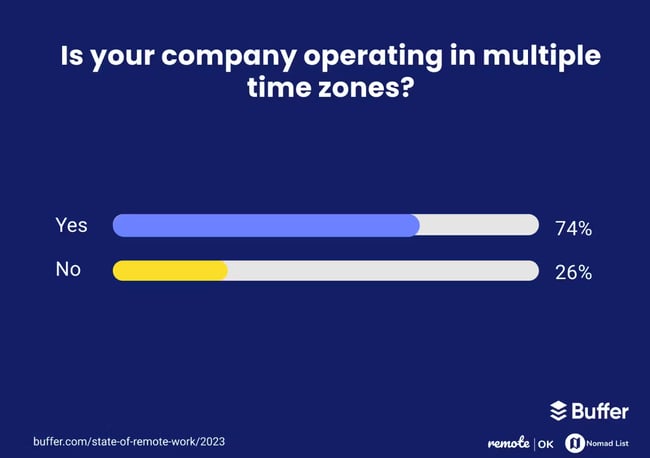
- This distributed setup impacts how remote teams collaborate. Currently, collaboration mainly occurs through messaging apps (50%), emails (22%), and meetings (19%), with video calls being the most common for meetings. Interestingly, only about one-third (36%) of employers have upgraded their video meeting technology since 2020.
- For virtual meetings specifically, a Buffer study found that when taking meetings, most remote workers prefer to be on camera. When asked why, 67% of participants felt it was easier to communicate when they could see someone’s expression.
- That said, not all meetings are viewed favorably by remote workers. A study by HubSpot revealed that 70% of employees find too many calls and meetings disruptive to their concentration. Additionally, 58% feel that at least half of the meetings they attend could have been handled through emails instead.
- Moreover, the same study also found that email was the preferred communication platform for a majority of respondents (39%) when asked to choose one platform for the upcoming year.
- On the side of the organizations, several studies have shown that employers are also taking measures to ensure seamless collaboration amongst remote teams. A 2022 study found that roughly half (50%) of employers have provided training to managers on managing remote and hybrid teams.
- Similarly, a HubSpot study found that 32% of employees who participated in their Hybrid Work survey had received guidelines on using unified communication and collaboration tools. Furthermore, 54% had received training on conducting effective and inclusive hybrid meetings.
- Finally, a recent study also found that 37% of employers have added or increased the use of employee tracking software, indicating a growing trend towards more effective monitoring and management of remote teams.
Challenges of Remote Work
- While remote work offers many benefits, it also presents several challenges. For some remote workers, the struggle lies in the isolation of staying home too often. One study found that one in three remote workers reported this as their biggest challenge, with loneliness following closely behind at 23%.
- A 2022 Hubspot survey also found that 40% of remote workers reportedly miss spontaneous, in-person connections with their colleagues,
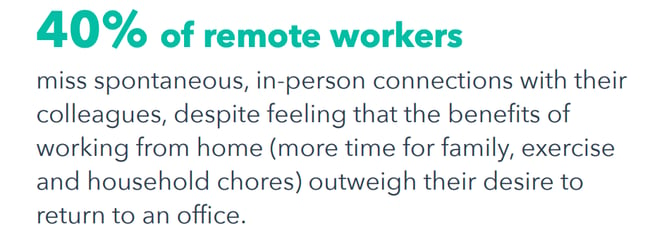
- There’s also the fact that not every employee thrives in a remote environment. A recent study found that nearly half of U.S. workers feel their teams do not function effectively in a hybrid environment.
- While this could likely be attributed to several reasons, a 2022 study found that 77% of remote workers who felt less productive attributed this to increased distractions at home, which is understandable considering that 45% of remote workers utilize multi-purpose spaces, such as bedrooms or kitchens, for work.
- Separating work and personal life can also be difficult in a remote setting. In one study, 81% of remote workers admitted to checking work emails outside of office hours, with 63% doing so on weekends and 34% while on vacation. Moreover, 48% often worked beyond traditional hours, with 44% reporting increased work hours compared to the previous year.
- Another study also found that nearly half (45%) of workers report an increase in work-related stress over the past year.
- Finally, another major challenge for remote work adoption seems to be workplace perceptions. One study found that 49% of workers feel that managers view in-office employees as harder working and more trustworthy than remote counterparts.
- Similarly, another study found that 10% of employees fear being perceived as less productive or committed if they work remotely.
Navigating The Remote Work Landscape
While remote work presents new and unique challenges, with the right approach and understanding, it can lead to more productive and satisfying working arrangements for both employees and employers.
Whether you‘re considering your first remote role or hiring remote team members, it’s important to keep the stats above in mind as the world continues to evolve and embrace flexibility.


.png)
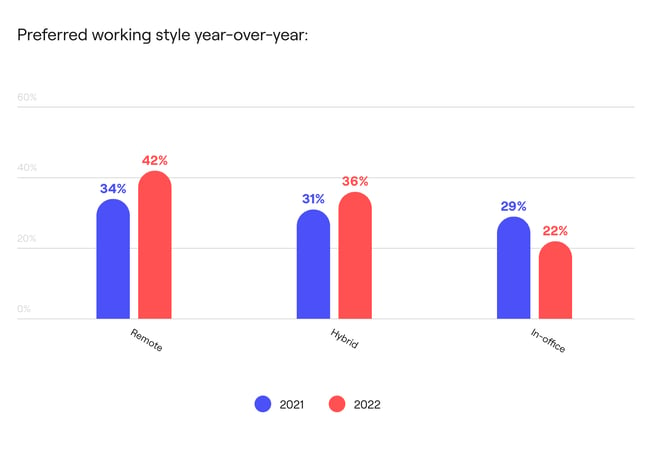
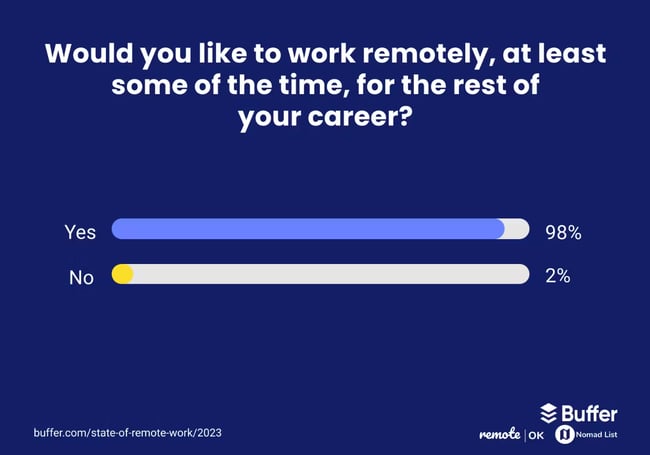



![How to Optimize for Google’s Featured Snippets [Updated for 2024]](https://moz.com/images/blog/Blog-OG-images/How-to-Optimize-for-Googles-Featured-Snippets-OG-Image.png?w=1200&h=630&q=82&auto=format&fit=crop&dm=1724004002&s=13df73104762982790dab6dc8328023f)


